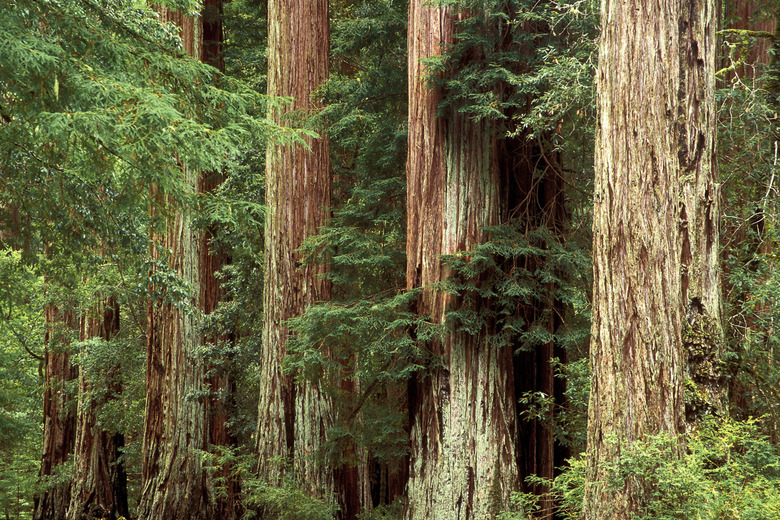Identifying Redwood Tree Diseases
Redwoods (Sequoia sempervirens), hardy in U.S. Department of Agriculture plant hardiness zones 7 through 9, are some of the most striking trees that you can find in a landscape. That's because they can grow to heights of over 300 feet and usually feature massive trunks. If you're lucky enough to have one in your yard, maintaining its appearance is probably a priority. Being able to identify the most common diseases that affect redwoods means that you can solve problems that crop up more quickly so the tree doesn't suffer permanent damage.
Canker
Redwood trees are susceptible to several types of canker disease, including redwood, cytospora and botrysophaeria cankers. The main symptom of this type of disease is the development of sunken areas of dead tissue, known as cankers, on the branches. Some cankers are not immediately apparent, but others are easy to spot because they are surrounded by layers of lumpy, disfigured tissue. The leaves on infected branches also begin to turn brown or yellow and show signs of wilting. The branches themselves may show discolored bark and produce excessive resin.
- Redwoods (Sequoia sempervirens), hardy in U.S. Department of Agriculture plant hardiness zones 7 through 9, are some of the most striking trees that you can find in a landscape.
- Some cankers are not immediately apparent, but others are easy to spot because they are surrounded by layers of lumpy, disfigured tissue.
Botrytis Blight
Botrytis blight is a disease that occurs in redwood trees caused by the Botrytis cinerea fungus, which spreads most easily in high humidity. Foliage of affected plants becomes discolored or develops spots. The needles and shoots may eventually wilt, die and fall off the tree. Botrytis blight is often identified by gray-brown spore masses on twigs, which may experience dieback as decay begins at the tips of leaves and moves along to the roots.
Collar, Foot, Root and Crown Rots
Redwood trees may experience collar, foot, root or crown rot, which is caused by the Phytophthora fungus. It affects the roots and crowns of the trees, causing leaves to discolor, become stunted and fall off. Rot can often be identified by cankers, stains or vertical streaks on the trunks of infected trees. The bark may also produce a reddish-brown or dark gray sap in infected sections. In a mature tree, rot can slow growth and may lead to a steady decline, with twig and branches experiencing dieback.
- Botrytis blight is a disease that occurs in redwood trees caused by the Botrytis cinerea fungus, which spreads most easily in high humidity.
- Botrytis blight is often identified by gray-brown spore masses on twigs, which may experience dieback as decay begins at the tips of leaves and moves along to the roots.
Cercospora Needle Blight
Cercospora needle blight affects the needles and new shoots of redwood trees. The affected needles turn a bronze or pink color in spring and often die by late summer or early fall. Some twigs and branches may experience dieback as well. Needles may also develop black fruiting bodies and take on a fuzzy appearance. Trees experiencing environmental stress such as lack of nutrients in the soil or drought conditions are usually more vulnerable to needle blight.
Sudden Oak Death
Sudden oak death is a disease caused by the microscopic pathogen Phytophthora ramorum that affects trees and plants in coastal California and a small area of southwest Oregon. Although it is usually found in forest areas, it can also affect redwoods in urban areas that run up to undeveloped wildland. The disease causes lethal cankers to develop on the bark of the trunk, twigs and branches, as well as discoloration and wilting of the foliage.
- Cercospora needle blight affects the needles and new shoots of redwood trees.
- The disease causes lethal cankers to develop on the bark of the trunk, twigs and branches, as well as discoloration and wilting of the foliage.
References
- University of California Agriculture & Natural Resources Integrated Pest Management Program: Coast redwood, Redwood, Sequoia—Sequoia sempervirens
- USDA Forest Service: Sequoia sempervirens
- University of California Agriculture & Natural Resources Integrated Pest Management Program: Canker Diseases
- University of California Agriculture & Natural Resources Integrated Pest Management Program: Botrytis blight—Botrytis cinerea
- University of California Agriculture & Natural Resources Integrated Pest Management Program: Collar, foot, root, and crown rots—Phytophthora spp.
- National Park Service: Sudden Oak Death
